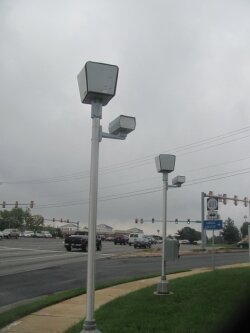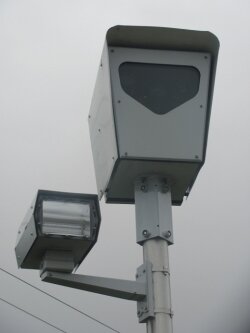Seeing green: Rio/29 cameras nab 7,638 drivers
County police say recent headlines about the PhotoSafe red light camera program at the intersection of Route 29 and Rio Road have given it a bad rap.
"Crashes Increase at Red Light Camera Intersection" read a Charlottesville Newsplex headline last week, which was then touted on cvillenews. However, the news sources may have committed the reporting equivalent of a rolling stop.
According to County police Sgt. Darrell Byers, the Newsplex reported that there were 23 crashes between December 11, 2010, the date the cameras went live, and July 31, 2011, compared to 22 crashes the year before. However, Byers suspects the Newsplex included accidents at entrances to the intersection not monitored by red-light cameras, or simply misinterpreted the data.
According to Byers, between December 2009 and July 2010 (before the cameras were operational), there were 11 crashes in the southbound lane of Route 29 where two cameras are now located, and three crashes in the westbound lane of Rio where one camera is located. Between December 2010 and July 2011 (when the cameras were in operation), there were eight crashes in the southbound Route 29 lane, and one crash in the westbound Rio lane. That's five fewer crashes than a similar period a year earlier.
"Crashes actually decreased after the cameras were installed at those specific locations," says Byers.
While there were no deadly t-bone crashes during either study period, the were four rear-end crashes, which research shows can be caused by red-light cameras, on Route 29 southbound with the cameras operational, compared to three before. There was one rear-end crash in the west lane of Rio, the same number as the year before. Before the cameras were installed, four accidents were caused by red-light running on 29 southbound, compared to only two after the cameras were installed.
"There's definitely different driving behavior at the intersection," Byers says.
Still, even though the cameras were touted as a safety initiative, the accident numbers "haven't changed much," Byers concedes.
"We want to change dangerous driver behavior– not ticket a bunch of drivers for illegal behavior," another County spokesperson said at the time. However, according to Byers, between December 11, 2010 and July 31, 2011, the cameras generated an incredible 7,638 tickets.
As the Hook reported, at a meeting, County Supervisor Dennis Rooker labeled the initiative a safety measure and "revenue enhancer," and critics accused the County of launching a cash grab.
However, as Byers points out, 3,202 of the tickets were rejected, either by RedFlex, the Australian company that operates the cameras, which first receives the video and photo data, or by County police, who review the data before tickets are mailed. Reasons for a rejection include blurred images or other inconclusive evidence.
For example, a driver might cross the stop line and trigger the camera but never enter the intersection. Indeed, a reporter witnessed a driver headed south on Route 29 who triggered a camera flash by inching too far across the stop line,but then backed up in a futile attempt not to be nabbed. Byers says that one of the accidents recorded at the intersection during the study period was caused by someone backing up. What constitutes a so-called "rolling stop" when a driver makes a right-on-red turn at Rio is also a police judgement call.
So, during the 7-month study period, County police issued 4,436 tickets at a rate of 700 to 1,000 a month. At $50 a ticket, that represents $221,800 in revenue. However, under the no-risk deal with RedFlex, the company takes up to $9,480 of revenue generated each month, with the County keeping any amount beyond that. The deal is no-risk because the County has to pay RedFlex only whatever money the tickets generate. For example, if only $6,000 in monthly ticket revenue were generated, the County would be obligated to pay only that amount.
Minus the $9,480 that goes to RedFlex each month, the County hauled in $155,440 in seven months, roughly $22,205 per month at only two approaches to the intersection, while RedFlex hauled in $66,360.
While Byers says that there is no data immediately available on the number of tickets issued while police were monitoring the intersection, he suspects it is considerably lower than the amount the automatic cameras have generated.
"But the presence of a police cruiser at the intersection tends to deter people," he says.


15 comments
221k in revenue for a reduction of five acidents.
sounds like a typical government program....
Anyone who confuses a program that both generates revenue and gets positive results with a "typical government program" is obviously not very observant.
As I commented before these things went in, pretty corrupt to the core is such an arrangement. As to accident statistics, why shouldn't the accidents of all types generated by the intersection be included in the numbers?
$66K a month to the grifters who installed these things is some mighty nice ROI for them and a nice synopsis of the modern collusion between corporate and state power...
"Accident prevention" was always just a euphemism for revenue generation. Mission accomplished.
So WE pay for this service imperpetuity, we never own this system we just keep paying. Who signed this contract? Civil servants are people to dumb to get a job somewhere else and we pay.
The north/south throughput at that light has improved greatly during rush hour.
It used to be that half of every green light was spent waiting for the red light runners crossing 29, or taking a left on to Rio, to get the hell out of the way.
Moving traffic = thumbs up.
Hope they put these on Hydraulic/29 next.
Go cams !
Better that crappy drivers pay for county services than me!
Why don't they pull a few cops away from Chipolte and have them sit on the other intersections to raise more money?
People need to get off their cell phones and stop tailing others who are doing the speed limit and maybe the numbers would be even lower for accidents.
Charlottesville is home to the worst drivers on earth. Also the greatest concentration of asshats per capita. There is evidently something in the water supply that turns many of the denizens of that podunk town into arrogant, unintentionally hilarious nimrods. Cville is the most overrated town in America.
"That's five fewer crashes than a similar period a year earlier."
Which may have happened even without the cameras. Comparing a group of bad drivers to another group of bad drivers does not really tell you anything of substance as to the effectiveness of the cameras.
One thing is sure: RedFlex gets a nice income stream from bad 29 North drivers.
re:"Cville is the most overrated town in America."
WE'RE NUMBER ONE AT THAT TOO?!?!
WOOOOOO-HOOOOOO!!!!!
CHARLOTTESVILLE! NUMBER ONE!!!
"Also the greatest concentration of asshats per capita."
Yepper; that's me.
Re worst drivers on earth, BollockstoCville has obviously never driven in San Juan. I'd have to assume that because we're the "most overrated town in America", that this guy has already moved away or is actively pursuing move because I know I wouldn't want to live in an overrated town.
I find the cameras very scary. I, and other drivers often try to avoid that intersection. So, I apologize to any neighborhoods we must drive through to avoid such a messed up system. When I do go through the intersection, I get scared, and often stop on the green to avoid the risk of getting a ticket. Or, if I do go through the intersection, I slam on my gas and honk my horn, rushing through as quickly as I can. Am I supposed to risk my life and others all because I'm scared of some crazy cameras? This town is unreasonably ridiculous.